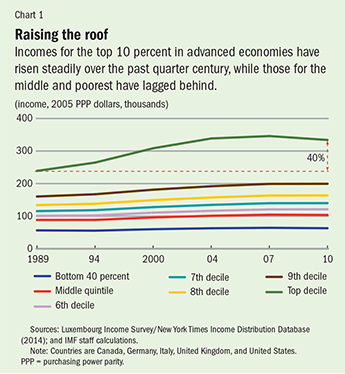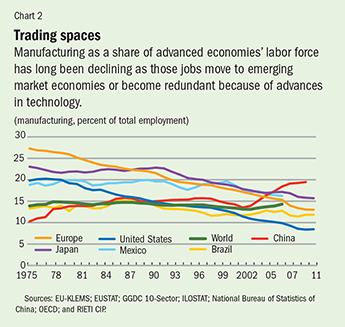Get on Track with Trade
Finance & Development, December 2016, Vol. 53, No. 4

Trade raises productivity but may hurt some unless policies redistribute the benefits
As the global economy struggles with slow growth, political support for freer international trade has weakened, most notably in advanced economies and especially in the United States. While some resistance to freer trade is nothing new, it never stopped the postwar trade liberalization process, which delivered growth in advanced economies and promoted convergence of per capita incomes throughout a significant portion of the developing world.
Opposition to trade remains a minority view—most people gain from trade, but it seems to have many more vocal enemies these days.
Trade enables a country to use its resources more efficiently. But the gains from that greater efficiency may be divided unevenly among a country’s citizens, so that some of them lose out. The result can be greater income inequality and disrupted lives.
Over the past quarter century, the global economy has seen a seismic transformation thanks to increased trade and technological and political changes. While there is much progress to cheer at the global level, most governments have not ensured that gains from economic growth—including those due to trade—are broadly shared. In some places, tepid and declining overall income growth has brought frustrations to a boil.
Trade’s benefits have always been unequally shared, and maybe more so in recent years. But its gains are all the more important in today’s low-growth environment. Countries must protect and expand these gains through policies that redistribute them more equitably. That will also make economies more resilient to a range of market forces, beyond those connected with globalization.
Trade and technology
Since World War II, progressive reduction in trade barriers such as tariffs and quotas has supported growth and welfare everywhere it was undertaken—in part by getting a greater variety of goods to households at lower prices. Even more important, trade also has powerful positive effects on productivity—that is, the efficiency with which global resources are used to produce economic goods. These gains are especially important to reap in a world where economic growth seems to be slowing.
The main reason trade enhances productivity is comparative advantage, as the British economist David Ricardo explained two centuries ago. For example, he said, if England and Portugal both can produce cloth and wine, output of the two goods is maximized when the country with the lower domestic opportunity cost of wine making specializes in producing it, while the other country specializes in cloth. Both trade partners gain from this specialization. Moreover, that specialization remains efficient even if one of the countries can produce both goods more efficiently than the other—that is, has an absolute productivity advantage in making both goods. Trade always raises the productivity of every country that allows it—a point often missed in public discourse today.
Empirical research supports Ricardo’s fundamental insight that trade fosters productivity. But the productivity and growth benefits of trade go far beyond Ricardo’s insight. With trade, competition from abroad forces domestic producers to raise their game. Trade also offers a wider variety of intermediate production inputs firms can use to produce at lower cost. Finally, exporters can learn better techniques through their engagement in foreign markets, and are forced to compete for customers by raising efficiency and upgrading product quality (for example, Dabla-Norris and Duval, 2016).
In Ricardo’s world, trade is like a new, better technology that simultaneously becomes available to all countries that open their borders and from which everyone benefits equally.
Trade sometimes works this way. But such positive accounts of trade throw no light on why some people bitterly oppose it.
There are two main aspects of trade that help explain the opposition. First, there are short-run costs of redeploying an economy’s resources out of the sector that shrinks under free trade. Some workers are stranded in a contracting cloth sector, perhaps unable to move to a wine-producing region or to learn wine-making skills quickly. In the real world, costs and inefficiencies can be protracted and fall harshly on some, making long-run gains to the economy feel abstract and irrelevant to them.
Second, even without adjustment problems, trade can worsen the domestic income distribution, even making some people worse off in absolute terms. In this case, although the country as a whole experiences increased productivity and income, some people may gain disproportionately, while others lose absolutely. For the losers, it feels like a raw deal (see box).
These so-called redistributive effects can arise not just through globalization, but through technological improvements that benefit some parts of the economy more than others. The sequence of events is almost identical if technical advances allow more cloth to be produced with the same input of unskilled and skilled workers while the wine production technology doesn’t change. Because trade is analogous to a technological improvement, it is no surprise that technology’s advance can redistribute income just as trade does. Yet, even though a substantial minority is skeptical of trade, almost no one opines against higher productivity.
A major challenge in understanding the link between globalization and income inequality is to filter out the important effects of other factors, such as changes in technology. To make this task more complicated, globalization and technology feed each other—indeed, globalization’s encouragement of technological progress is an important source of gains from trade.
Why may some people lose from trade?
There are many ways some people can lose from trade, but economists Wolfgang Stolper and Paul Samuelson provided one of the simplest and most influential theoretical examples in a 1941 paper. Suppose that wine and cloth production both rely on skilled and unskilled workers, but that wine requires relatively more skilled winemakers and cloth employs mostly unskilled factory hands. If cloth production shrinks as a result of freer trade, newly unemployed unskilled workers somehow have to find jobs in the expanding wine sector, where there are relatively few low-skill jobs, even though that sector as a whole is growing. The only way the unskilled former workers can be reemployed in wine is if their wages fall and those of skilled workers rise, so that all businesses in the wine sector have an incentive to substitute unskilled for skilled workers—for example, by leveraging fewer skilled workers to supervise teams of the unskilled.
Inequality between and within nations
Even as there has been some drop in income inequality between nations in recent decades, inequality has risen within many nations. Trade and technology have both spurred the global convergence of incomes for many in poorer countries while shifting production patterns and income distribution within nations.
The most striking examples of reduced inequality between nations come from Asia, notably, the graduation of Hong Kong SAR, Korea, Singapore, and Taiwan Province of China to high-income status and the recent economic growth of China and India. India’s per capita real GDP grew from $553 in 1991 (in 2010 dollars) to $1,806 in 2015 while China’s rose spectacularly, from $783 in 1991 to $6,416 in 2015. Given these countries’ enormous populations, the Chinese and Indian success stories contribute to a large drop in inequality among the world’s population. Slower-growing Latin America and sub-Saharan Africa have not reduced their gaps with richer countries as quickly, but the incidence of poverty has fallen considerably in the poorer countries.
These advances in income convergence and poverty reduction owe much to global trade and investment—if not to free-trade policies in many cases, then to an outward orientation of production.
The fruits of growth, however, have not always been distributed equally in emerging market and developing economies. Roughly speaking, inequality has worsened most in Asia and eastern Europe, whereas in parts of Latin America—Brazil is a notable example—it has declined, while remaining high compared with much of the rest of the world.

Increased inequality in nearly all advanced economies, coupled with the recent slowdown in economic growth, has led to relatively slow long-term growth in household incomes except at the top (see Chart 1). The causes of the slowdown are complex, but they stem partly from the global financial crisis.
The U.S. case illustrates how economic growth in advanced economies has become less inclusive as it has slowed over the postwar period. In 2014, U.S. real median annual family income was $53,657 according to U.S. Census Bureau data, roughly the same in real (inflation-adjusted) terms as in 1989. In contrast, this measure of income nearly doubled between the early 1950s and the late 1980s. After a period of rapid and more widely shared economic advancement, at least half of U.S. households missed the benefits of economic growth over the past quarter century. (This was before an abrupt 5.2 percent jump in median income in 2015—whose durability remains to be seen.)
To a substantial degree, these developments reflect idiosyncratic national developments—such as changes in tax progressivity, executive pay constraints, or the financialization of the economy. But globalization and technology are at least potentially universal drivers, so it is important to try to quantify their respective roles. As noted, though, globalization and technology are intertwined. Technological innovations, such as in information and communication technology (ICT), have made more trade possible—for example, in services such as banking and insurance. Given the opportunity to enter export markets, or faced with import competition, businesses may innovate to upgrade production processes. Foreign direct investment as well as trade can result in the spread of technological best practice across borders, which itself influences patterns of comparative advantage. In other words, globalized trade itself helps to make technology a global factor.
Global transformation
Events of the tumultuous past quarter century leave little doubt that both trade and technology have played significant roles in altering production and wage patterns worldwide. Around the start of the 1990s, several developments converged to transform the global economy. The Soviet bloc collapsed, freeing its members in eastern Europe and Asia to move to market-driven economies open to international trade and investment. About the same time, China, which had begun to embrace the market in 1978, accelerated the process, in particular by authorizing more firms to engage in trade and lowering barriers to imports and exports. Other countries in the emerging world became more open to trade too, including several countries in Latin America hoping to put a near decade of debt-ridden low growth behind them and India, which implemented a wide-ranging reform in 1991. In many cases, openness to foreign direct investment and other types of financial flows also increased, further promoting exports.
These developments were widely welcomed at the time, and rightly so. They created a global trading system more extensive than at any other time in human history. They promised not only greater economic and in some cases political freedom for billions throughout the world, but also more buoyant growth driven by rising global incomes, consumption, investment, and innovation. Growth accelerated in many emerging market economies, in some cases raising domestic inequality as certain people proved more able than others to profit from the new opportunities. Still, for the first time, significant middle classes emerged in countries such as China and India.
But important distributional consequences of these global changes also became apparent, notably for advanced economy workers facing a sharply higher global supply of labor—much of it low skilled. As of 2000, China, India, and the Soviet bloc countries had contributed nearly 1.5 billion workers to the world economy, doubling its labor force (Freeman, 2007). Stolper-Samuelson reasoning suggests the increase in the global ratio of labor to capital would depress labor compensation relative to capital income in the advanced economies; this is likely part of the story behind both the long-term sluggishness of median wages and the fall in labor’s share of GDP in North America, western Europe, and Japan. That process was reinforced by the decline of labor unions and the related rise in businesses’ willingness to shift production to low-wage venues offshore.
Stolper-Samuelson logic also implies that low-skilled workers in poorer countries would see their relative wages pulled up while high-skilled workers would benefit in rich countries, lowering wage inequality in poorer economies and raising it in richer ones. But in fact the gap between the wages of skilled and unskilled workers rose for both country groups after the 1980s. Also contradicting the Stolper-Samuelson story was the tendency for such skill premiums to rise even within industries, with no evidence that industries in advanced economies were employing higher shares of low-skilled workers in response to the fall in their relative cost.
Many economists believe that the global evolution of the skill premium through the late 1990s is explained mainly by shifts in technology favoring higher-skilled workers—for example, the ICT revolution—another globally transformative and widely acclaimed change that accelerated in the early 1990s. But expanded trade could still have played a role, as exporting firms within industries have been found to use relatively more skilled labor than those that do not export, and increased trade would therefore feed the demand for skills. Another likely channel is outsourcing: shifts of low-skill activities from rich to poorer countries can raise the skill premium everywhere (Feenstra and Hanson, 1996).
Since the early 2000s globalization, including full integration of China into the global trading system, has accelerated. Increased educational investment by emerging markets allowed greater offshoring of routinized manufacturing and service-industry tasks, as well as a surge in high-tech exports, notably from China. In advanced economies, middle-skill jobs have been disappearing—a phenomenon known as “job polarization.” While some polarization is attributable to trade and offshoring, there is also a possibly dominant technological component, as routine tasks become increasingly automated (Goos, Manning, and Salomons, 2014).

Only recently have enough detailed data accumulated to identify convincingly long-lived negative effects of Chinese imports and offshoring on employment in import-competing industries, local labor markets, and wages. Manufacturing’s share of the labor force has declined across the advanced economies due to relatively strong productivity growth in that sector. But the U.S. decline in the 2000s was especially sharp, in part because firms sent capital abroad to produce goods there for export back into the United States, including from China (see Chart 2).
If workers displaced from U.S. manufacturing can find reemployment at all, they must accept significantly lower wages, evidence shows (Autor, Dorn, and Hanson, 2016; Ebenstein, Harrison, and McMillan, forthcoming). The phenomenon of workers displaced by import competition suffering long-term wage losses and unemployment occurs in a broad range of countries, including emerging market economies. It is also a long-standing problem, exacerbated recently by aging advanced-economy workforces and the sheer size of the disruptions associated with China’s rapid export growth.
From safety nets to trampolines
More shocks on the scale of those that created the new global economy likely are not in the cards, but the political and economic aftershocks remain substantial, and similar—albeit smaller—disruptions will surely occur. What can governments do to head off protectionist policies while defending and extending the gains from trade?
In its 1989 report, Adjusting to Win, the Canadian Advisory Council on Adjustment contrasted “safety net” policies—which protect those subject to job loss, for example, through unemployment benefits—with “trampoline” policies that offer a springboard to new jobs (Trebilcock, 2014). Both are important, but trampoline policies—which include active policies like job counseling and retraining—help people adjust faster when economic shocks occur, reducing long unemployment spells and the resulting depreciation of skills and employability. Such programs, which already exist in many advanced economies, deserve further study so that all can benefit from best practice.
Trampoline programs are helpful—and likely necessary—for all sorts of changes, not just those related to trade. It is hard to identify specifically trade-related job losses—and the economic case for government intervention to hasten movement of workers to new occupations is compelling whether the need arises from trade or other change in the economy. Policies that help people adjust include educational investments to create a nimble workforce, expenditure on needed infrastructure, investment in health, improved availability of housing, lowered barriers to entry for new businesses, and well-functioning financial markets. Such policies have the added benefit of also supporting growth.
Safety net programs have a role to play too. More open economies may be more susceptible to external shocks, and therefore require more extensive social safety nets. Governments can offer broader partial wage insurance for workers displaced into lower-paying jobs (Kletzer and Litan, 2001) and offer employers wage subsidies for hiring displaced workers. Programs such as the U.S. earned income tax credit should be extended to further narrow income gaps while encouraging people to work. More progressive tax and transfer policies must play a role in spreading globalization’s economic benefits more broadly.
As increased capital mobility across borders has fueled international tax competition, governments find it harder to finance safety nets and adjustment programs without inordinately high taxes on labor or regressive consumption taxes. As a result, we need international coordination against tax avoidance to prevent the bulk of globalization gains from accruing disproportionately to capital. If these inequities continue unchecked, political support for trade will weaken further.
No guarantees
Globalization offers the potential of economic gains for all, but there is no guarantee that potential will be realized absent decisive government action to support those who suffer from the side effects. Years of seismic global transformation since the early 1990s, coupled with persistently low economic growth following the financial crisis, have left many individuals and communities behind. As a result, a backlash against further trade and trade liberalization is crystallizing in a number of advanced economies.
Trade and trade policies have not, however, been the only factors behind these changes—they probably were not even the most important—nor are they the reason for slower growth. Technological changes as well as idiosyncratic national developments also have played major roles. The political consensus that drove trade policy over much of the postwar period will dissipate without a purposeful policy framework that spreads the risks of economic openness; ensures flexible labor markets and educated, agile workforces; promotes job matching; improves the functioning of financial markets; and directly addresses inequality of incomes. This same framework is needed to address a range of other economic changes, which, like trade, can harm some and require adjustment within the economy.
Trade is special only in the illusion that governments can shut out the rest of the world when the world becomes inconvenient. In the 21st century, however, interdependence is not optional. ■
References
Autor, David H., David Dorn, and Gordon H. Hanson, 2016, “The China Shock: Learning from Labor Market Adjustment to Large Changes in Trade,” NBER Working Paper 21906 (Cambridge, Massachusetts: National Bureau of Economic Research).
Dabla-Norris, Era, and Romain Duval, 2016, “How Lowering Trade Barriers Can Revive Global Productivity and Growth,” iMFdirect, posted June 20.
Ebenstein, Avraham, Ann Harrison, and Margaret McMillan, forthcoming, “Why Are American Workers Getting Poorer? China, Trade, and Offshoring,” in The Factory-Free Economy, ed. by Lionel Fontagné and Ann Harrison (New York: Oxford University Press).
Feenstra, Robert C., and Gordon H. Hanson, 1996, “Globalization, Outsourcing, and Wage Inequality,” American Economic Review, Vol. 86, No. 2, pp. 240–45.
Freeman, Richard B., “The Great Doubling: The Challenge of the New Global Labor Market,” 2007, in Ending Poverty in America: How to Restore the American Dream, ed. by John Edwards, Marion Crain, and Arne L. Kalleberg (New York: New Press).
Goos, Maarten, Alan Manning, and Anna Salomons, 2014, “Explaining Job Polarization: Routine-Biased Technical Change and Offshoring,” American Economic Review, Vol. 104, No. 8, pp. 2509–26.
Kletzer, Lori G., and Robert E. Litan, 2001, “A Prescription to Relieve Worker Anxiety,” Policy Brief 73 (Washington: Brookings Institution).
Trebilcock, Michael J., 2014, Dealing with Losers: The Political Economy of Policy Transitions (New York: Oxford University Press).
Opinions expressed in articles and other materials are those of the authors; they do not necessarily reflect IMF policy.


